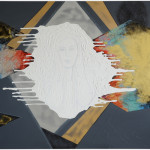The artistic journey of Veronika Drahotová traverses everything from objects via inter-media installations to photography and painting. During the last few years her paintings have undergone an intense metamorphosis, her well-established ironic, pop-art methodology becoming increasingly schematized, abstractive and subtilized.
In picturing the line of motives, her symbols, expressions and forms are still very much in evidence: the burning heart, a rosary, a chain, a cross, horned animal skulls. These symbols cross the spectrum of various expressive forms and create a highly personal “iconographic language,” as the artist herself calls it. These new paintings are a radicalization of those previous expressions, a transformation of traditional strategies and establishment of new rules that seek the broadest manifestation of meaning.
In Drahotová’s paintings the traditional visual depth of the picture is explicitly denied, as exemplified in the book Devant L’image (In front of the image) by the French art-theoretician Georges Didi-Huberman. An example of the denial of depth is the dripped wall of The Madonna of the Shadows by Fra Angelico in the San Marco Museum, the paintings of Jackson Pollock and the plasmic pictures” of Barnett Newman. The paintings of Veronika Drahotová are visually dominated by areas and their fractures. Her pictures stress the variance of distance, the anticipated depth and substance of place and the open interpretation of its expression. Depth is in places thrown towards the front, elsewhere it recedes; the view suddenly stopped by an impenetrable or corrugated area, causing a vertiginous effect.
Deleuze and Guattari find in painting an abstract machine of “enfacing”. Its extremes are the black hole and the white wall. The paintings come out of the black hole of subjectivity and are projected on a white wall. The subject is objecting itself. The I is placing itself among the others. They and I form our own view. This is a very courageous view of the self. The Unknown known – the black hole of a well, the black hole of an eye, the eye – the well, the look inside your own eye.
The shutting up of the senses to explore outer consciousness, the subconscious filtration of reality. We donť know it, but we do it: we indulge in the locked room mystery. The stone panels, areas, counterpoints in the abstract machine: “Even if the painting becomes abstract, it again and again finds the black hole and the white wall, the great composition of the canvas and the black split. A breaking but also a tearing of the canvas is an axis of escape, a point of escape, a diagonal, a cut wound, a split or a hole: and there you go, here is a machine which creates faces and landscapes, even the most abstract ones.” (Deleuze-Guattari).
The white wall and the black hole give birth to a face and a countryside: “The abstract machine is not working, only creating faces but also in various grades in the parts of the body, the clothes, the objects it interprets according to the rule of reasons…” (ibid). A hand, a feather, a lamp and a rosary, a shadow on a white wall, anaclastic fractures, black stains. Amor fati – the inspiration by Nietzsche – the ability to see the beauty in the necessity of things: lines, threads, chains, clouds, shadows, scapes, thorns, bodies. No war against the ugliness, the only negation be the gaze withdrawn: see no evil, hear no evil, speak no evil…that is the substance of the radical painting of Veronika Drahotová.
Prague, August 6, 2011 Michal Tošner













